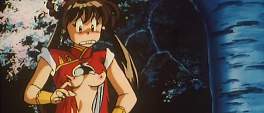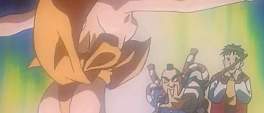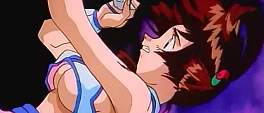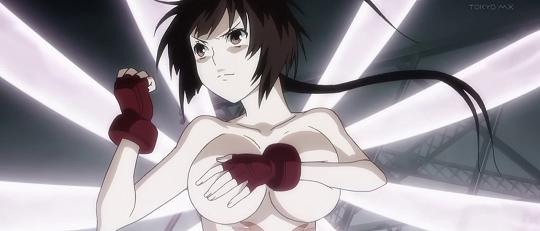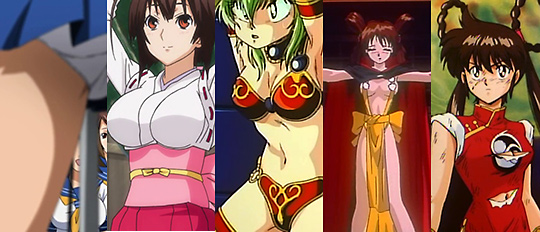
The recent airing of the second series of Hyakka Ryouran Samurai Girls poses the question of why the stylish but lacklustre first season was deemed worthy of a sequel, but also conjures up the spirit of genre stalwarts such as the long running Sekirei and Ikkitousen franchises - each series with a more ridiculous alliterative subtitle than the last - as well as one-offs such as Tenjho Tenge. The specific taxonomy of these series is usually spread between "fantasy", "martial arts" and the all-encompassing "fan service" categories, but works equally well as just "fighting fanservice" (FF).
With a few exceptions, the entire point of these series is to group voluptuous girls together so they can beat seven shades of tar out of one another, usually with disastrous consequences for their clothing and decency. Twice tickling the lizard brain for those who are titillated by such things then: violence and sex. Tweak the variables from breasts to blood though and you have horror (see Blood-C, Elfen Lied, Ga-Rei Zero etc.). Catering to base desires though doesn't leave a lot of room for story or character development with many of the plot lines and episodic stories simplistic even if they were in a children's Saturday morning cartoon and utterly worthless for anything other than hurtling the cast from one arena to the next.
The line these series walk though is a fine one, caught between tawdriness and storytelling: you tip too far into the former and you get pornography along the lines of the "does what it says on the tin" Sexy Magical Girl; into the latter and you get the kind of twee, heart rending stories the likes of which Vividred and Strike Witches are known for. The premise of these series, from Queen's Blade to Ben-To, lends itself to a different kind of fan-service than the usual panty-flashes and deep cleavage shots that pepper other series and although many use the inherent eroticism to cover up for bland and uninteresting tussles, this wasn't always the case.
Step back to 1990 for what some would call the earliest example of fighting fanservice and Devil Hunter Yohko reveals a different take. Instead of the sapphic overdrive that many post 2000 FF series revel in, Yohko is mad about boys and, somewhat refreshingly, longs for her first sexual experience. Then she's revealed to be a hunter of otherworldly monsters and every boy she is attracted to is either possessed or is taken over by a demon. The series has the seeds of the raunchy humour (the first episode's sexual assault scene not withstanding) that would later be perfected in the mid-nineties classic Golden Boy while also merging together the warrior woman and magical girl (Sailor Moon et. al.) genres, immortalising itself with a now iconic topless transformation sequence.
Coming a full year before the west's interpretation of the genre (minus the nudity) with Buffy The Vampire Slayer, for many years Devil Hunter Yohko ruled the genre roost of female combat and fan service. It was somewhat preceded by 1986's Outlanders that skewed more towards science fiction and a doe-eyed lead, but is succeeded reverentially by Demon Fighter Kocho in 1997, the titular Kocho even sporting Yohko's signature cheongsam ensemble. It could be argued however that the entire genre owes a debt to Cutey Honey in its many iterations over the years. Regardless, the late nineties saw an upheaval of anime tastes which meant it wasn't until a few years into the new millennium that Ikkitousen sparked renewed interest in the "girls punching each other, oh look breasts" genre.
Both the first series of Ikkitousen and the later Tenjho Tenge (based off Oh Great's manga started in 2000) kept the male contingent of their respective stories (such as they are) but wisely chose not to highlight the strength differences between male and female fighters. As the genre continued ("matured" would be an entirely inaccurate description) males were dropped for lesbian undertones and a more marketable premise, keeping pesky penises out of the pugilism. From there you have a kaleidoscope of different interpretations, from Claymore that goes out of its way to thoroughly desexualise its combatants through to My-HiME with its more standoffish inclusion of biomechanical critters or even Kämpfer with its gender bending antics.
It's difficult to pin down exactly why the genre as an umbrella for so many different series seems to have taken off over the past decade. Anime series have always leaned towards the smutty long before GAINAX introduced their jiggle in Gunbuster but perhaps the introduction of digital technology has allowed fighting to be a more cost-effective premise - you only have to look back at the Street Fighter II anime movie to see how difficult decent combat is to hand animate. Or perhaps the lack of sexual history, specifically the low-budget Hollywood exploitation films of the 70's and 80's, has finally flowered. Or attitudes towards sexuality in anime have become more mainstream, or just more accepted; it's easier to sell a fighting series with fanservice as acceptable than just unabashed softcore pornography.
It's equally difficult to know whether the shift to an almost entirely female cast structure is a step forward or back for female representation in anime, objectifying them more yet giving more space for character nuance in between all the flesh on display. This of course ignoring the one-guy-many-girls structure retained elsewhere. Whether you like or loathe the premise it's clear that smutty, double-X chromosome fighting still sells and though the format of it has changed with tastes over the years, it is now looking increasingly unlikey to be "just a phase" for anime as a whole.
